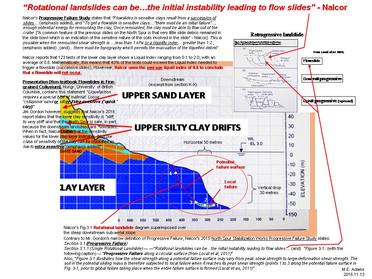 Initial underwater instability can lead to multiple failure surfaces/successive landslides (flowsides)
Initial underwater instability can lead to multiple failure surfaces/successive landslides (flowsides) Mr. Gordon disagrees with Dr. Bernander's statement that "...layers with high sensitivity...occur in the Lower Clay formation". Instead, Mr. Gordon states that "the clay is characterised as “stiff to very stiff"... (and that) NALCOR data from tests on soil samples retrieved from the lower clay layer do not indicate the presence of soft clays"
- FACT:- Nalcor's 2016 North Spur Stabilization Works Design Report actually states that the sensitivity values for the lower clay layer indicate "that the class of sensitivity of the clay can be classified as low to extra sensitive" (emphasis added)”. Furthermore, the University of British Columbia [Hungr, Non-textbook Flowslides in Fine-grained Colluvium], states that "Liquefaction requires a special type of material: Loose, 'collapsive' sand or silt or Extra-sensitive ("quick" clay)"].
- Also, Nalcor's 2016 document goes on to say that the lower clay Liquid Index ranges from 0.1 to 2.0 over 123 tests, which means mathematically, that up to 43% of the Liquid Index tests may show the lower clay layer to be above the safe Liquid Index cut off of 1.2.
- Notwithstanding this fact, Nalcor's Progressive Failure Study relies on the lower clay layer's AVERAGE liquid index of 0.6 to conclude that "no flowslide or retrogression landslide may develop ... (and that accordingly)... The landslide would... be limited to a single rotational slide of limited depth"
- While the facts show that Nalcor classifies the sensitivity of the lower clay layer as "low to extra sensitive", the UBC (Hungr) presentation defines "Extra sensitive" (clay) as "quick" clay", and up to 43% of the Liquid Index tests may be above the 1.2 level required to allow large, retrogressive, multiple failure/landslides to occur, somehow Mr. Gordon now agrees with Nalcor and now takes a revised position that does not seem to be supported by the facts.
 RSS Feed
RSS Feed
